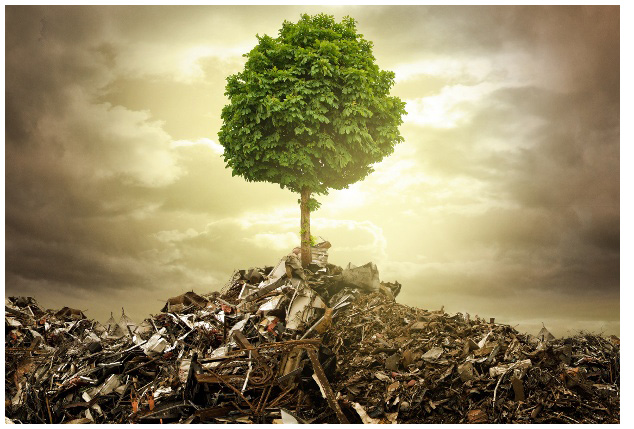Many in the general public believe that the term 'plastics' has always been best associated with processes, which sought to manufacture entirely synthetic materials. Before the invention of Bakelite however -regarded as the first synthetic plastic- it should not be forgotten that the initial scientific interest in plastics was to develop products that were engineered from natural substances. Alexander Parkes and his development of celluloid were first made from cellulose plants by dissolving them into a nitrate solution and by adding camphor. First-generation bioplastics came from traditional agricultural and renewable resources such as soybeans, sugarcane and corn. As time went on, the development of second-generation sources for bioplastics have emerged from non-food sources such as sawdust, as well as from various byproducts of first-generation sources such as stover and bagasse. The interest here has not just been to develop bioplastics from renewable materials but also to reduce carbon footprints by using surplus and leftover biomass materials. A third-generation of research has also emerged in recent years which seeks to use material outside of standard feedstocks and utilizes algae and modified methanobacteria for the development of bioplastics.
According to industry surveys, the general public tends to have a limited understanding of plastics and bioplastics and often believe that ‘biobased’ and ‘biodegradable’ mean the same thing. The common misconception is that these two terms are naturally linked. The general public does not have apparent knowledge of the fact that biobased bioplastic materials may not necessarily be biodegradable and that bioplastics that are biodegradable may not necessarily be biobased. According to the same survey, consumers do however, understand the various benefits of bioplastics in reducing dependence on fossil fuels and reducing carbon footprints. They also understand that bioplastics can help to mitigate global warming and that biodegradable materials reduce the impact on landfill sites and problems with litter.
Bioplastics: New Challenges
Lesser known among consumers are the complicated nuances associated with bioplastic recycling and disposal. Government regulators are continuing to work with industry to develop standards for measuring renewable carbon content within plastic as well as measuring it for industrial compost. With the reduction of oil prices in recent years, traditional plastics and polymers have maintained themselves as an attractive choice for business. Still, due to their unique properties – biobased, sustainable and biodegradable - research into bioplastics continue to play an important role as the plastics industry continues to expand. Establishing standards for biodegradation including, anaerobic digestion, home compostability and marine degradability continue to be central focus for the industry and governments. The challenges that remain for the bioplastics industry have as much to do with harmonizing regulations and standards as much as they have to do with communicating accurately with consumers. Improvements for testing and certification has seen significant efforts made by the EU and by France and Italy in particular but other countries need to improve their level of participation. Debates -particularly in the United States - over whether special considerations should be given to food, fuel or bioplastics, resonates throughout the news and popular culture. Even food industry leaders like Frito-Lay and its SunChips brand found it necessary to deal with consumer backlash after it introduced ‘stiffer’ biodegradable bags. Apparently, many consumers found the bags to be ‘too noisy’ when agitated and the company had to go back to the drawing board, deciding to introduce new adhesion technologies to its bags to reduce the noise decibels that were being generated by eating the chips from the bags. The ‘Sunchips’ case study shows some of the best advantages of early adoption of bioplastics. PepsiCo’s (owner of Frido-Lay / Sunchips) showed significant brand leadership in working to adopt new biodegradable packaging and received significantly positive media exposure for this environmental initiative. That it also worked hard to address and 'tweak' the product to better align with consumer demands for a quieter form of packages. This action demonstrated the industry's ability to meet consumer demand while, at the same time, addressing the clear need for more environmentally friendly products.

Biodegradability is only one of the key areas where bioplastics can make a difference. Innovations made by industry as well as participation by government regulators will continue to usher in positive changes for the future. Continued efforts to communicate effectively with consumers will also be an essential part of the way the bioplastics industry needs to meet the expectations of that future.